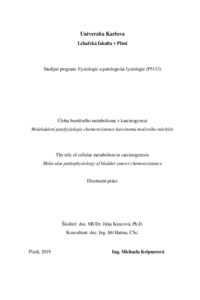Úloha buněčného metabolismu v karcinogenezi. Molekulární patofyziologie chemorezistence karcinomu močového měchýře
The Role of Cellular Metabolism in Carcinogenesis. Molecular Pathophysiology of Bladder Cancer Chemoresistance
dizertační práce (OBHÁJENO)

Zobrazit/
Trvalý odkaz
http://hdl.handle.net/20.500.11956/110241Identifikátory
SIS: 150323
Katalog UK: 990022949540106986
Kolekce
- Kvalifikační práce [341]
Autor
Vedoucí práce
Konzultant práce
Hatina, Jiří
Oponent práce
Nevoral, Jan
Chovanec, Miroslav
Fakulta / součást
Lékařská fakulta v Plzni
Obor
-
Katedra / ústav / klinika
Ústav biologie
Datum obhajoby
16. 9. 2019
Nakladatel
Univerzita Karlova, Lékařská fakulta v PlzniJazyk
Čeština
Známka
Prospěl/a
Klíčová slova (česky)
karcinom močového měchýře, kmenové buňky, mnohočetná léková rezistence, nádorově asociované fibroblasty, terapeutická rezistenceKlíčová slova (anglicky)
Bladder Cancer, Stem Cells, Multidrug Resistance, Cancer Associated Fibroblast, Therapeutic ResistanceTerapeutická rezistence nádor p edstavuje závažný klinický problém. Z hlediska klinického pr b hu vzniku rezistentního fenotypu rozlišujeme primární rezistenci, kdy nádor v bec nereaguje na aplikovanou terapii, a rezistenci získanou neboli sekundární, kdy po po áte ní klinické odpov di terapie p estává p sobit a nádor se stává chemo,- radio- i imunorezistentní. Z hlediska mechanismu terapeutické rezistence m žeme rozlišit bun n autonomní rezistentní fenotypy od p ípad rezistence založené na komplexních interakcích v rámci nádorového mikroprost edí. Experimentální modely terapeutické rezistence nádor vychází asto ze vstupního modelu senzitivních nádorových bun ných linií a selekce dce iné chemo- i radiorezistentní bun né linie po aplikaci p íslušného cytostatika, pop . experimentální radioterapie. V rámci p edkládané dizerta ní práce jsme odvodili dva unikátní modely terapeutické rezistence urotheliálního karcinomu. První model vychází z námi odvozené bun né linie BC44 a dce iné bun né linie BC44DoxoR, která byla odvozena prolongovanou expozicí mate ské bun né linie BC44 doxorubicinu. Tato dce iná chemorezistentní linie vykazuje bun n autonomní fenotyp mnoho etné lékové rezistence, s rezistencí v i ty em dalším cytostatik m (cisplatina, metotrexát, vinblastin a gemcitabin). BC44DoxoR vykazuje...
Therapeutic resistance of tumours represents an important clinical issue. We can classify the therapeutic tumour resistance in two ways. According to the clinical course, tumours can behave either as primary resistant, i.e. from the very beginning not responsive, or they can display a secondary (also called acquired) resistance, whereby an initial clinical response is lost and the tumour develops into chemo-, radio- or immunoresistant disease. An alternative classification distinguishes cell autonomous resistance mechanisms from resistance that relies on complex interactions within the context of tumour microenvironment. From the research perspective, modelling therapeutic resistance frequently involves experimental treatment of sensitive cancer cells and selection of daughter resistant cell lines. The Ph.D. thesis includes derivation of two unique models of urothelial bladder carcinoma therapeutic resistance. The first model involves newly established urothelial carcinoma cell lines BC44 and BC44DoxoR, which resulted from a prolonged doxorubicin exposure of the mother cell line. The daughter chemoresistant cell line exhibits multidrug resistant phenotype, which extends beyond the selecting drug - doxorubicin - to four additional chemotherapeutic drugs (cisplatin, methotrexate, vinblastine, and...
